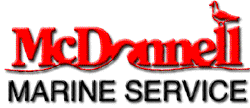Volvo
Penta IPS revealed
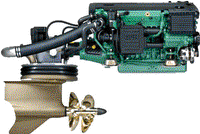 |
Download
the IPS400/500 Spec Sheet HERE
|
Volvo have just rewritten the rules with regard motorboat
propulsion systems. In a stroke they may have consigned
stern-drives and shaft drives to history, and in the
process revolutionized the way motorboats are designed
and built.
Inboard Performance System, or IPS, is an innocuous
title for the most important development in propulsion
since the invention of the outdrive, and something
that may render the conventional shaftdrive obsolete.
IPS is a combined engine and propulsion system, sold
as a package in the same way that an outdrive can be.
You can't buy the propulsion unit on its own, and currently
IPS is only approved for twin installation. There are
two models, both employing the same propulsion/transmission
unit. Combining this unit with the 310hp D6-310 gives
the IPS-400, attach the 370hp D6-370 and you have the
IPS-500. The engines are the same as used in sterndrive
and conventional shaftdrive applications.
Lets start by listing the main benefits compared with
conventional shaftdrive, go on to see how those benefits
are delivered, and then look at the implications of
this system for recreational craft of the future. For
implications there certainly are, especially for manufacturers
of diesels in the 350hp to 500hp bracket. The longer
term depends on whether Volvo intend to develop the
concept to accept greater power outputs. And I think
we can all guess the answer to that
Higher efficiency
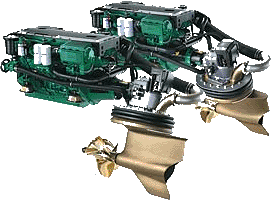
Significantly increased propulsive efficiency is one
of the key benefits of IPS, but that increase has
been made possible only by a fundamental rethink
of propulsion principles. About the only thing IPS
has in common with conventional shaftdrive is that
it uses fully submerged propellers rather than jets
or surface-piercing propellers.
IPS uses two forward-facing contra-rotating propellers
per unit. The superior efficiency of twin contra-rotating
propellers over a single larger diameter one was appreciated
many years ago, and Volvo's Duoprop outdrive is the
established manifestation of that theory. Because they
operate in clear water, propellers work better in tractor
(pulling) form than in pusher mode but shaftdrive installation
naturally ensured that the pusher principle has remained
dominant in the marine world.
Forty-plus knots
Another advantage of the IPS propulsion unit is the
ability to break through the 40-knot barrier that
the inefficiency of conventional propellers imposes.
This is significant because propulsion for 40 knots
plus boats has traditionally been the preserve of
relatively expensive surface drives like the Arneson
or Buzzi drive. We're not yet in a position to directly
compare the handling and performance of all the different
drive systems, but the IPS does seem to provide the
potential for a new generation of higher speed boats
that inhabit the mainstream rather than the esoteric.
Improved handling
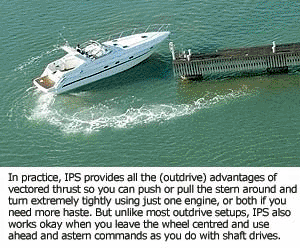
Great news for devotees of outdrive legs, the handling
of the IPS will delight you. And excellent news for
shaft drive junkies, the handling of the IPS will charm
you too. The impossible dream? It would appear not.
Nowhere was this more evident than driving the Sealine
S42 sportscruiser. This is the boat we have tested
more than any other, and in all its forms; with outdrive
legs, with Buzzi surface drives, with shaft drives,
and with Volvo, Yanmar and Mercruiser engines.
Low speed maneuverability was excellent. In practice,
IPS provides all the (outdrive) advantages of vectored
thrust so you can push or pull the stern around and
turn extremely tightly using just one engine, or both
if you need more haste. But unlike most outdrive setups,
IPS also works okay when you leave the wheel centered
and use ahead and astern commands as you do with shaft
drives. The response is slower but still distinctly
shaft-like.
The drive units also have plenty of keel area so they
provide remarkably good directional stability. Pottering
out of the marina on just one engine required only
the slightest deflection of the wheel, and like shafts
and rudders, side winds have less effect than on outdrive
leg boats. The great thing is that you can pick and
choose depending on what you are trying to achieve.
Center the IPS and turn in your own length. Or vector
the IPS, dab the bow thruster, and see yourself pulling
smartly sideways and backwards (or forwards) out of
a tricky cross-tide marina berth. Master the IPS fully
and you will be giving those implausibly maneuverable
twin jet-drive boats a run for their money.
At high speed, the good directional stability remains.
Rudders work well at medium to high speed but IPS permits
a tighter turning radius and better speed through the
turns because, like outdrive legs, there is nothing
blocking the prop wash.
Reduced noise and vibration
Again, the Sealine S42 provided the perfect yardstick.
It was not possible to measure noise accurately (too
many excited journalists onboard gabbling away) but
subjectively there was no doubt whatsoever; the IPS
S42 was significantly quieter than its counterparts.
IPS makes things far quieter and noticeably smoother
largely because the propulsion unit feeds thrust loads
directly into the hull, allowing the use of much softer
engine mounts. This is the same principle used by the
highly effective Aquadrive coupling. Vibration damping
is further enhanced because thrust is transmitted via
two large-diameter rubber O-rings, which also provide
the watertight seal between the IPS unit and the hull.
Reduced maintenance
Worries about long-term maintenance is something that
shaftdrive devotees often cite for avoiding outdrive
legs. Fortunately, the maintenance requirements of
IPS should be minimal. Certainly far less than an outdrive
and possible even cheaper than a conventional shaft
drive set-up due to the elimination of the sterngland
and P-bracket bearing. The steering motor is maintenance
free and there are no tilt, trim or steering joints
to worry about. Accessibility is outstanding which
makes keeping an eye on the condition things like the
rubber exhaust hoses dead simple; outdrive owners have
permission to eat their hearts out. The mechanical
parts of the IPS transmission that come into contact
with the water are made almost entirely of stainless
steel. The leg is made from bronze, rather than aluminum
,and the propellers from a special nibral (nickel aluminum
bronze) instead of stainless steel. Volvo hope this
will negate the corrosion problems that so plague aluminum
outdrives in certain circumstances. The only anode
is a small cast-iron cylinder inside the exhaust outlet.
Increased safety
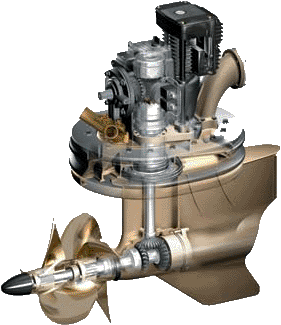
We now come to what looks like the IPS's Achilles heel:
what happens if you hit an underwater obstruction.
As you might expect, Volvo have given this aspect a
great deal of thought. There are two entirely different
scenarios: low speed contact with the bottom and a
high-speed encounter with a submerged object.
Touching the bottom at low speed shouldn't be a problem
as the skeg on the bottom extends below the propellers.
The subsequent vertical force is transmitted into the
robust GRP mounting ring inside the hull and assuming
the engines are put into neutral promptly, no damage
should result.
In the high-speed scenario, the leg and pod will shear
off flush with the hull. The lower bearing carrier
has been engineered specially to break at a point below
the O-ring seal between the fixed and steerable parts
of the drive. As the leg bends backwards, the vertical
drive shaft simply pulls out of its spline. The inside
of the transmission is now open to the ocean but no
water can escape into the boat and the vital mounting
joint between transmission and hull will remain not
only intact but undamaged thanks to the energy absorption
of the big twin O-rings.
More room on board
Existing flybridge boats could take advantage of IPS
by installing the engines in what was the lazarette
and using the old engine room under the saloon floor
for storage. But the full benefits of IPS will only
be realized by entirely new interior layouts - some
of which will undoubtedly feature an extra cabin or
more. The rearward weight change of IPS also provides
the opportunity for transverse fuel tanks located at
the center of gravity, meaning no trim change in relation
to fuel contents.
What the future holds
At present IPS consists of just one transmission unit
and a choice of two engines, 310hp and 370hp. Bearing
in mind the 35% or so efficiency gains over shaftdrives,
that suggests a take-up on boats designed for around
350hp to 500hp. IPS blends seamlessly with Volvo Penta's
existing sterndrive packages of between 130hp and 350hp,
so the company now have the 26-46ft (8-14m) market
covered with the exception of shaftdrive flybridge
cruisers around 33ft and single engine designs. But
there doesn't seem any technical reason why the leg
shouldn't be coupled to the recently uprated 260hp
D4 for smaller boats where outdrive legs would be unsuitable.
And if IPS settles down in service without any major
teething problems, it will probably be certified for
use with higher horsepower engines within about 18
months.
For power outputs above 500hp an entirely new transmission
would probably be needed, but there are no technical
impediments to producing an 'IPS 750' capable of absorbing
the D12's 715hp. In fact, I'd be surprised if such
a unit wasn't already on the drawing board. That could
make IPS the power system of choice for virtually all
recreational craft up to about 65ft - which is the
vast majority in terms of units built.
IPS
represents a multi-million pound investment and
five-year R&D
project for Volvo Penta, so it's unlikely that we
will be seeing a competitive product
emerging any time soon. But perhaps the most important
aspect is that IPS puts Volvo Penta in the unique position
of being not just a supplier of engines for inboard
boats but a provider of complete inboard propulsion,
steering and instrumentation packages. I hope they
are tooled up for the rush.
